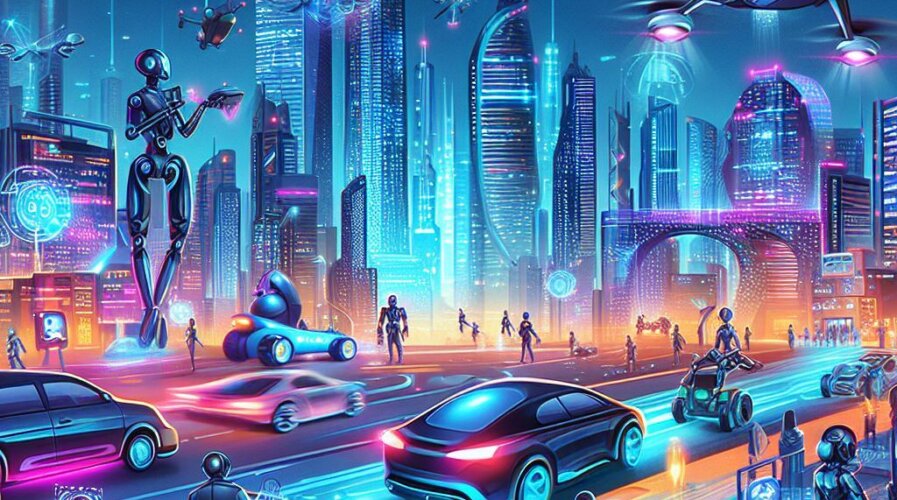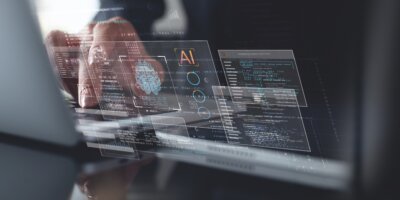
What can we expect from AI and automation in 2024? (Generated with AI)
What could AI and automation look like in 2024?
|
Getting your Trinity Audio player ready... |
- 2024 to see generative AI drive industry transformation and new trends.
- AI’s growing role in customer service boosts efficiency and productivity.
- AI evolves with intuitive virtual assistants and ‘hands-free’ automation for smarter workplaces.
2023 has unmistakably been the year of AI, particularly generative AI in the tech industry, and this trend shows no signs of slowing down as we head into 2024.
Generative AI is a potent tool poised to democratize technology’s transformative power.
Exploring the expansive capabilities of generative AI trends in 2024
Here are Tech Wire Asia‘s insights into the AI trends for 2024. The impressive capabilities of generative AI applications stem from training on vast datasets. GPT-4, powering ChatGPT, operates on over one trillion parameters. Similarly, other Large Language Models (LLMs) like Google’s PaLM2 and DeepMind’s Gopher are based on hundreds of billions of parameters.
The imminent arrival of GPT-5 is anticipated to mark a significant leap in scale. While increasing dataset size isn’t the only method to enhance an LLM’s intelligence, it has proven to be the most effective way of advancing performance. This trend is expected to continue shaping the evolution of new generative AI models in 2024.
Given the younger generation’s preference for video content, AI tool developers are rapidly creating tools to adress demand. Historically, producing video content has been costly, requiring skilled professionals for creation and editing. However, with the advent of generative video tools, 2024 could see anyone creating high-quality video content at a fraction of the current cost.

An X user expresses the excitement of using AI for memes. (Source – X)
In customer service, AI integration is proving to be a game changer. Blending routine tasks with complex, critical operations, AI is set to change the field by handling more initial customer interactions, customizing solutions to common problems, and efficiently summarizing customer interactions.
According to a Boston Consulting Group survey, 95% of customer service leaders anticipate AI bots serving their customers in the next three years.
The augmentation of human intelligence and capabilities with AI in the workplace will be increasingly important for efficiency and safetyand will be evident in various professions. Legal workers, for example, will use AI to summarize case law and draft contracts quickly. Doctors will employ AI to compile patient notes and interpret medical images. Software developers will find AI indispensable in speeding up coding, testing, and debugging.
We suspect students will find AI instrumental in organizing their notes and research, and job-seekers will use it to refine their resumes and cover letters, marking a new era in the symbiotic relationship between human and artificial intelligence.
Insights on AI trends and virtual assistants in 2024
Tech Wire Asia recently sought insights from Jess O’Reilly, Area Vice President, Asia, at UiPath, to delve deeper into the AI trends. O’Reilly shared her perspective on the future of AI, particularly highlighting that LLMs will revolutionize virtual personal assistants.
O’Reilly said a combination of automation, generative AI, and specialized AI is transforming virtual assistants into highly proactive, intuitive, and communicative tools. The transformation is redefining our interaction with machines and is expected to trigger a surge in productivity.

Jess O’Reilly, Area Vice President, Asia, at UiPath, discusses AI and automation trends of 2024.
“Just like the best human assistants, autopilots can quickly learn to complete a wide range of activities and take proactive steps to make workflows faster and smoother,” she said. “Some capabilities include copying and pasting images into webforms, spreadsheets, and enterprise software systems (ERPs, CRMs, etc.) with minimal training; reading and responding to emails; extracting attachments; and generating reports.”
She said autopilots are adept at comprehending work contexts and manual tasks, potentially leading to the creation of automation that replaces repetitive work. This shift can free up valuable time for employees to engage in more impactful activities and enhance overall workstream efficiency.
O’Reilly underscored the accessibility and user-friendliness of virtual assistants (UiPath’s Autopilot among them), predicting their widespread adoption in the Asia Pacific region. With a significant proportion of knowledge workers hoping for AI-assisted productivity, including 26% of Singapore’s workforce facing increased work pressures, implementing these virtual aids is expected to boost productivity and well-being, contributing to a more sustainable work culture in regional organizations.
Evolving AI applications: From autopilots to virtual aids
“Ironically, automation has historically required a considerable amount of manual work to be fully functional. This paradigm will shift in the coming year, with the emergence of “hands-free” enhancements in automation – all of which help significantly reduce the time, expertise, and effort needed for fueling intelligent automated workflows,” she explained.
She mentioned the future of no-code development in AI, enabling teams to convert natural language into automation of processes, streamlining behavior modeling and automating the more tedious aspects of model training.
Reflecting on Gartner’s 2019 prediction that 65 percent of application development would be done with low-code/no-code tools by 2024, O’Reilly opines this prediction might hold true. With tools like Copilot simplifying application development and testing, the landscape of coding and software engineering is set to evolve, opening to individuals with creative ideas and problem-solving abilities; not necessarily with advanced technical skills.
She spoke of the evolving nature of automation, which will not only detect automata execution issues but also be capable of self-correction and autonomous problem-solving. With half of Singapore’s workforce already relying on automation for IT and technical issue resolution, these self-correcting features will further cement automation’s role in addressing technical challenges.
The need for effective AI governance and regulatory frameworks
Currently, there’s no universally accepted standard on AI regulation, but governments are taking steps to establish trusted AI frameworks. These focus on areas like privacy, security, and ethical data handling. A notable example is the collaboration between Singapore’s Infocomm Media Development Authority (IMDA) and the AI Verify Foundation, which led to the launch of the Gen AI Evaluation Sandbox, that aims to re-evaluate generative AI technologies.
With regards to data privacy and protection laws related to AI, O’Reilly notes that corporate leaders are aware of risks associated with AI misuse. A proactive approach is expected to lead to the development of new safeguards to fine-tune the balance between AI’s risks and benefits.
“Effective AI governance will become paramount for achieving robust AI outcomes. In 2024, an increasing number of organizations will witness the evolution of AI governance from aspiration to implementation guided by innovation as enterprise software companies build AI controls into their own offerings. AI providers and scientists will shift their focus towards constructing additional layers of trust, so organizations can confidently leverage new AI capabilities with the knowledge that their data is secure,” O’Reilly concluded.
2024 promises to be a year of significant advancement and transformation in the realm of AI. As we stand at the cusp of these changes, it is an exciting time to witness and participate in the unfolding of this new era of artificial intelligence.
READ MORE
- Safer Automation: How Sophic and Firmus Succeeded in Malaysia with MDEC’s Support
- Privilege granted, not gained: Intelligent authorization for enhanced infrastructure productivity
- Low-Code produces the Proof-of-Possibilities
- New Wearables Enable Staff to Work Faster and Safer
- Experts weigh in on Oracle’s departure from adland


